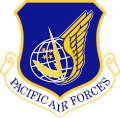- Selfridge Field, Michigan, 15 January 1941
- Harding Field, Louisiana, 6 October 1941
- Fort Dix Army Air Base, New Jersey, 19–20 January 1942
- Camp Darley, Victoria, Australia, 27 February 1942
- Nouméa Airfield, New Caledonia, 15 March 1942
- Tontouta Airfield, Nouméa, New Caledonia, 17 March 1942 (air echelon operated from Henderson Field, Guadalcanal, Solomon Islands, 22 August–22 December 1942 and 29 January-c. 9 April 1943)
- Oua Tom Airfield, La Foa, New Caledonia, 24 April 1943 (air echelon operated from Port Moresby Airfield Complex, New Guinea, 30 May–28 June 1943)
- Gurney Airfield, Milne Bay, New Guinea, 17 June 1943
- Woodlark Airfield, New Guinea, 23 July 1943 (air echelon operated from Munda Airfield, New Georgia, Solomon Islands, 28 October–16 December 1943)
- Renard Field, Banika Island, Russell Islands, 23 January 1944 (air echelon operated from Torokina Airfield, Bougainville Island, Solomon Islands 2 March–3 April 1944, detachment of air echelon operated from Stirling Airfield, Stirling Island, Solomon Islands, 8–25 May 1944); air echelon operated from Stirling Airfield, Stirling Island, Solomon Islands, 18 July–16 August 1944)
- Middleburg Airfield, Netherlands East Indies, 15 August 1944
- McGuire Field, Mindoro, Philippines, 22 February 1945 (air echelon operated from Wama Airfield, Morotai, Netherlands East Indies, 12 February–21 March 1945)
- Puerto Princesa Airfield, Palawan, Philippines, 6 March 1945 (air echelon operated from Laoag Airfield, Luzon, Philippines, 9–28 August 1945)
- Moret Field, Mindanao, Philippines, c. October 1945
- Laoag Airfield, Luzon, Philippines, October 1945
- Puerto Princesa Airfield, Palawan, Philippines, 8 February 1946
- Floridablanca Airfield, Luzon, Philippines, 17 July 1946
- Clark Field (later Clark Air Force Base), Luzon, Philippines, 16 September 1947
- Deployed to Kadena Air Base, Okinawa, 1–7 March 1949
| - Ashiya Air Base, Japan, 30 July 1950
- Pusan East Air Base, South Korea, 8 September 1950
- Pyongyang East Air Base, North Korea, 21 November 1950
- Suwon Air Base, South Korea, 1 December 1950
- Chinhae Air Base, South Korea, c. 16 December 1950 (operated from Pusan West Air Base, South Korea, 27 March-c. 23 April 1951, Suwon Auxiliary Air Base, South Korea, 7 April-c. 8 May 1951, Seoul Air Base, South Korea, 8 May–9 August 1951 and 19 August–30 September 1951; Hoengsong Air Base, South Korea, 1 October 1951 – 1 June 1952
- Hoengsong Air Base, South Korea, 2 June 1952 (operated from Taegu Air Base, South Korea, 17–21 September 1952)
- Osan-ni Air Base, South Korea, 10 January 1953
- Kadena Air Base, Okinawa, 30 October 1954 (deployed to Yontan Auxiliary Air Base, Okinawa, 10 November–11 December 1954; Chiayi Air Base, Taiwan, 27 January–17 February 1955 and 1 July – 1 October 1955; Korat Royal Thai Air Force Base, Thailand, 18 February–26 April 1965 and 16 August–23 October 1965)
- Misawa Air Base, Japan, 15 December 1967 (deployed to Taegu Air Base, South Korea, 7 October – 8 December 1968, 3 March – 3 April 1969, 2 June – 2 July 1969, 30 August – 1 October 1969, 1–18 January 1970, 16 February–2 March 1970 and 29 March–8 April 1970); Kunsan Air Base, South Korea, 8–12 April 1970, 10–24 May 1970, 21 June–4 July 1970, 18 July–25 August 1970, 15–29 November 1970, 10–22 January 1971, and 5–15 February 1971)
- Kadena Air Base, Okinawa (later Japan), 15 March 1971 – present (deployed to Kunsan Air Base, South Korea, 2 June–28 July 1972 and 8 September–16 October 1972; Ching Chuan Kang Air Base, Taiwan, 8 November 1972 – 14 July 1973, 5–26 August 1973, 16 September–7 October 1973, 28 October–18 November 1973, 9–30 December 1973, 20 January–10 February 1974, 2–23 March 1974, 13 April–4 May 1974, 25 May–15 June 1974, 2–27 July 1974, 16 October–1 December 1974, 9 January–20 February 1975, and 20 April–30 May 1975 [2]
- Ching Chuan Kang Air Base, Taichung, Taiwan, 6 November 1972 – 31 May 1975
- Chiayi Air Base, Chiayi, Taiwan, 27 January – 17 February 1955 and 1 July – 1 October 1955 [2]
|









